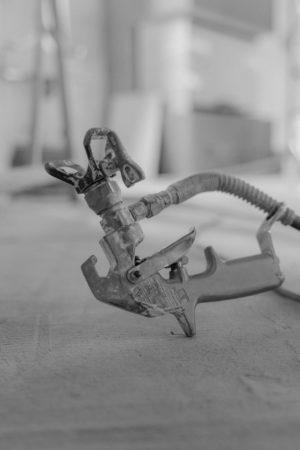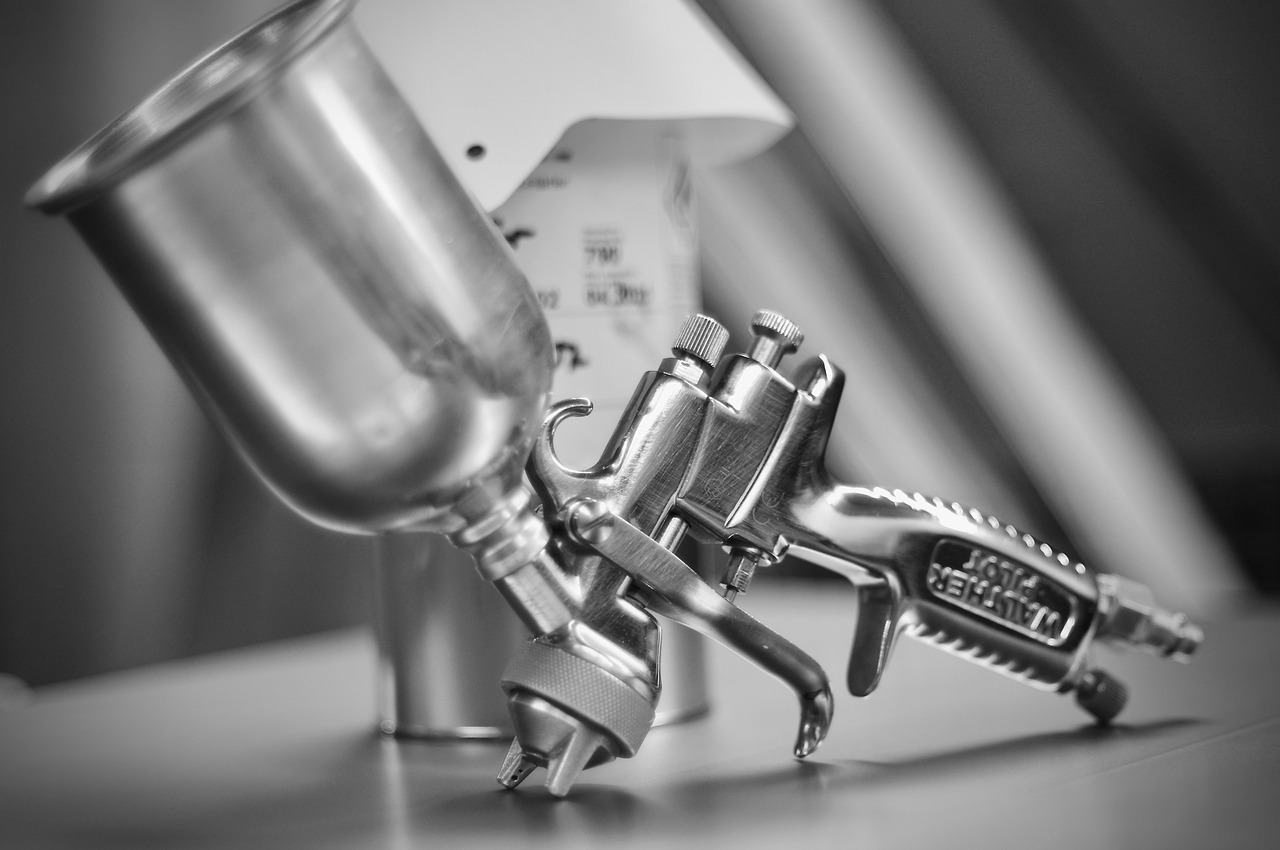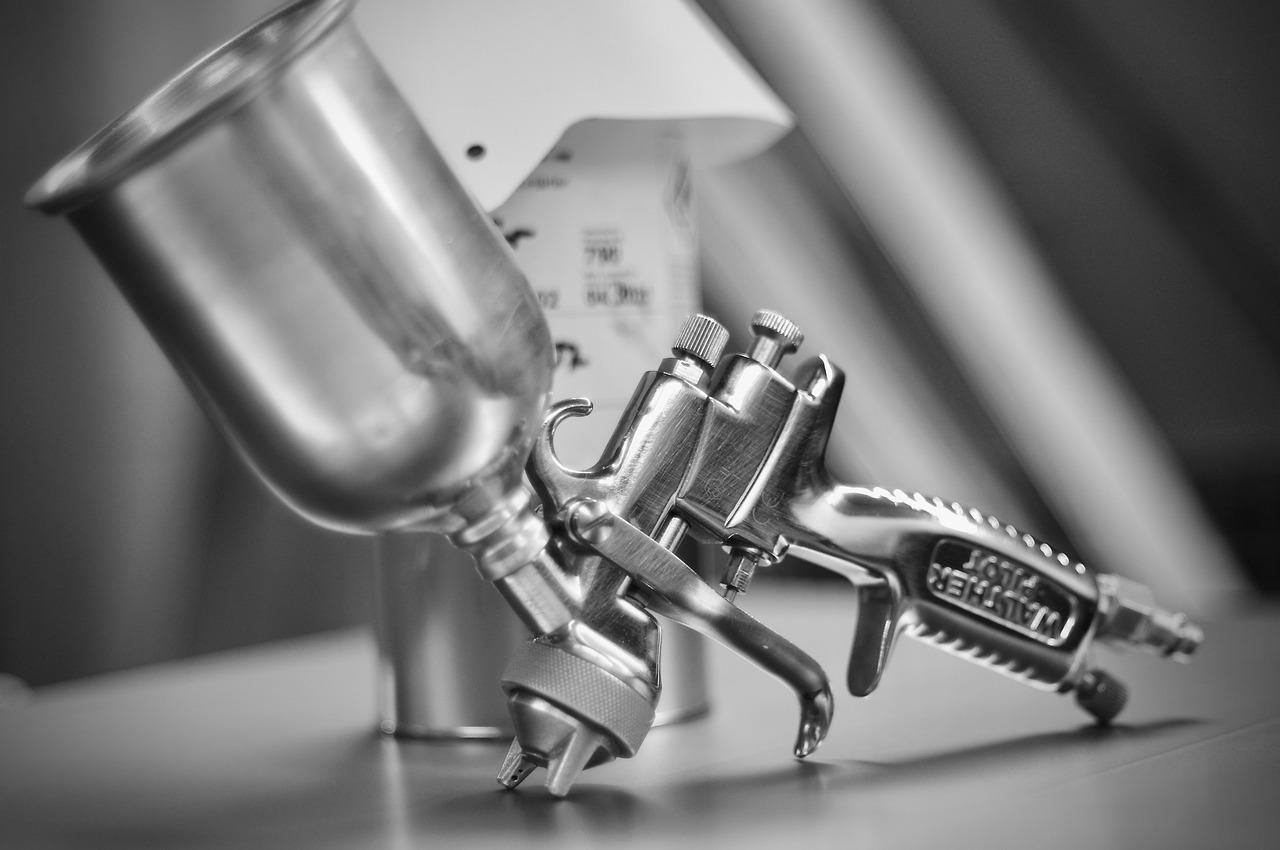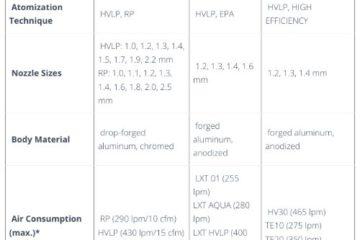Airless Paint Sprayer vs Air Spray Gun
What is the difference between an airless spray gun and an air spray gun? And which is better air or airless paint sprayer? These are common questions when it comes to spray painting. Here is an overview of both paint atomization systems, including a comparison and tip selection chart for both airless paint sprayers (SYNO: airless spraying, airless atomization) and air paint sprayers (SYNO: air spraying, conventional spraying, air atomization).
Contents
Comparison between Airless Spraying and Air Spraying
| Airless Spraying | Conventional/Air Spraying | |
 |   | |
| Means of Atomization | by the use of high pressure to create a high velocity of fluid through a small orifice. | by jets of compressed air from air cap/air nozzle |
| Atomization Finishing | generally coarser | high-quality finishing possible |
| Fluid Pressure | 500-4500 psi [35-310 bar] | low, usually 12-18 psi [0.9-1.3] bar at nozzle |
| Compressed Air/Compressor required? | Yes (for airless pump*) | Yes (for spray gun/air cap) |
| Air Consumption | 1/4 to 1/2 less than air spray | 4-20 cfm [113-570 lpm] |
| Fluid Delivery | high delivery, fastest application speed, suitable for large areas | low to medium delivery, slower application speed |
| Overspray | more overspray | less overspray |
| Materials/Fluids | uniform particle size is important (heavy pigmented or fiber filled materials may not work) | basically no restrictions |
| Main Equipment needed | – Spray Gun – airless type – Airless Pump – Fluid Hoses – high pressure | – Spray Gun – air spray type – Air hoses (Option: Pressure Pot with Fluid hoses) |
How does an Airless Paint Sprayer (Airless Atomization) work?
Airless spraying does not use compressed air to atomize the paint or coating material. High pressure (500-4500 psi / 35-310 bar) is used to create high fluid velocity to pump fluid through a small orifice of the spray gun. When the fluid is released at such high velocity, the fluid breaks into small droplets resulting in a fine spray.
Summarized: Atomization is accomplished by using high pressure to create high fluid velocity through a small orifice. No air is needed (air pressure is only needed to operate the airless pump)
Tip Selection Chart (Airless Sprayer)
| Type of Paints | Viscosity in seconds (Ford #4 / Zahn #2) | Orifice (inch / mm) | |
| Lacquers, Sealers, Stains, Enamels | 20-25 / 30-38 | .011-.015″ / 0.3-0.4 mm | |
| Primers, Plastic Enamels, Aluminums | 28-35 / 43-53 | .015-.018″ / 0.4-0.5 mm | |
| Latex | 35-40 / 53-63 | .015-.031″ / 0.5-0.8 mm |
How does an Air Paint Spray Gun (Air Atomization) work?
Paint or coating material is delivered to the spray gun by either gravity (cup on top) siphon/suction (cup on bottom) or pressure (connected to a pressure pot). When the fluid leaves the spray gun via the fluid nozzle, jets of compressed air from the air cap (SYNO: air nozzle) tear the material apart into small droplets.
Summarized: Atomization is accomplished by jets of compressed air from air cap.
Nozzle Selection Chart (Air Paint Sprayer)
Gravity Feed System
| Viscosity Range | Viscosity in seconds (Zahn #2) | Orifice (inch / mm) |
| Very Thin | 0.020-0.04″ / 0.5-1.0 mm | |
| Thin | <15-20 seconds | 0.05-0.06″ / 1.2- 1.4 mm |
| Medium | 20-60 seconds | 0.065-0.085″ / 1.6-2.0 mm |
| Heavy | >60 seconds | 0.095-0.110″ / 2.3-2.8 mm |
| Very Heavy | 0.130-0.500″ / 3.2-12.7 mm |
Pressure Feed System
| Viscosity Range | Viscosity (Zahn #2) | Orifice (inch / mm) |
| Very Thin | 0.020-0.030″ / 0.5-0.8 mm | |
| Thin | <15-20 seconds | 0.040-0.051″ / 1.0-1.3 mm |
| Medium | 20-60 seconds | 0.055-0.063″ / 1.4-1.6 mm |
| Heavy | >60 seconds | 0.070-0.110″ / 1.8-2.8 mm |
| Very Heavy | 0.125-0.500″ / 3.2-12.7 mm |
Airless Paint Sprayer vs Air Assisted
Air-assisted airless spraying is a paint application method that combines the technologies of airless and conventional air spraying. Instead of relying solely on the high-pressure pump to atomize the paint, the air-assisted airless system also uses a separate stream of compressed air to break the paint into smaller droplets and create a softer spray pattern.
It works like this: A high-pressure fluid pump delivers coating material at pressures ranging from 600 to 1500 psi (41.4 to 103.4 bar) to a spray gun containing an airless tip. The airless tip pre-atomizes the coating, creating a dense, slow-moving pattern. A small amount of compressed air, from 5 to 30 psi (0.34 to 2.1 bar), is introduced to soften and complete the atomization.
This combination of high pressure and compressed air results in a more controlled and uniform spray pattern with reduced overspray and increased transfer efficiency. Air-assisted airless spraying is often used for high-quality finishes on woodwork, metalwork and other surfaces where a smooth and consistent finish is desired.
FAQ: How to Use an Airless Spray Painter?


